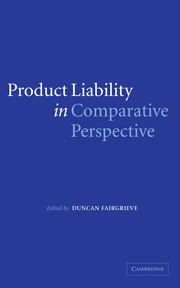Book contents
- Frontmatter
- Contents
- List of figures
- Foreword by Sir Michael Burton
- List of contributors
- Preface
- 1 Introduction
- PART I Country reports
- 2 The use of comparative law in A & Others v National Blood Authority
- 3 Spanish product liability today – adapting to the ‘new’ rules
- 4 Interaction between the European Directive on Product Liability and the former liability regime in Italy
- 5 L'Exception française? The French law of product liability
- 6 German product liability law: between European Directives, American Restatements and common sense
- 7 Dutch case law on the EU Product Liability Directive
- 8 Defect in English law – lessons for the harmonisation of European product liability
- PART II European influences
- PART III Comparing systems
- Appendix
- Index
3 - Spanish product liability today – adapting to the ‘new’ rules
from PART I - Country reports
Published online by Cambridge University Press: 28 July 2009
- Frontmatter
- Contents
- List of figures
- Foreword by Sir Michael Burton
- List of contributors
- Preface
- 1 Introduction
- PART I Country reports
- 2 The use of comparative law in A & Others v National Blood Authority
- 3 Spanish product liability today – adapting to the ‘new’ rules
- 4 Interaction between the European Directive on Product Liability and the former liability regime in Italy
- 5 L'Exception française? The French law of product liability
- 6 German product liability law: between European Directives, American Restatements and common sense
- 7 Dutch case law on the EU Product Liability Directive
- 8 Defect in English law – lessons for the harmonisation of European product liability
- PART II European influences
- PART III Comparing systems
- Appendix
- Index
Summary
Introduction: the application of the Spanish Product Liability Act by the courts
Until 2003 the judgments of the Spanish Supreme Court were referring to the Spanish Product Liability Act (Ley de responsabilidad civil por los daños causados por productos defectuosos (hereafter, Product Liability Act or LRPD)) only obiter dicta, as a sort of reminder of its existence. They dealt with facts that had taken place before the new regulation implementing the Product Liability Directive was applicable and, therefore, they applied the rules of the General Act for the Protection of Consumers and Users (Ley general para la defensa de consumidores y usuarios (hereafter, Consumer Protection Act or LGDCU)), an Act which had governed product liability in Spain since 1984.
Errors and omissions excepted, STS 21.2.2003 (RJ 2003\2133) was the first judgment where the Supreme Court applied the Product Liability Act implementing the Directive. In this case, a bottle of white lemonade exploded while the claimant was putting it into his shopping basket in the supermarket. The splinters of glass injured both his face and one eye, and caused him the partial loss of sight in his left eye. The victim filed a claim against the soft-drink and the bottling companies seeking a damages award of 36,520,000 Pta (approx. €220,000). The Court of First Instance decided in favour of the claimant, but awarded the substantially lesser sum of 7,720,000 Pta (approx. €46,000), and this judgment was confirmed by the Court of Appeal and, finally, by the Supreme Court.
- Type
- Chapter
- Information
- Product Liability in Comparative Perspective , pp. 42 - 66Publisher: Cambridge University PressPrint publication year: 2005



